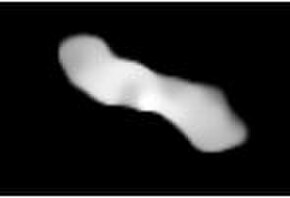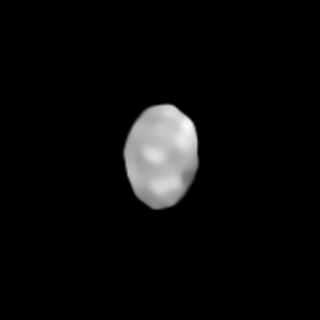
16 Psyche is a large M-type asteroid, which was discovered by the Italian astronomer Annibale de Gasparis, on 17 March 1852 and named after the Greek goddess Psyche. The prefix "16" signifies that it was the sixteenth minor planet in order of discovery. It is the largest and most massive of the M-type asteroids, and one of the dozen most massive asteroids. It has a mean diameter of approximately 220 kilometers (140 mi) and contains about one percent of the mass of the asteroid belt. It was thought to be the exposed core of a protoplanet, but recent observations cast doubt on that hypothesis. Psyche will be explored by NASA, with a spacecraft of the same name, marking the first time a manmade object will journey to a metallic asteroid, launched on 13 October 2023, with an expected arrival in 2029.

Cybele, minor planet designation 65 Cybele, is one of the largest asteroids in the Solar System. It is located in the outer asteroid belt. It is thought to be a remnant primordial body. It gives its name to the Cybele group of asteroids that orbit outward from the Sun from the 2:1 orbital resonance with Jupiter. The X-type asteroid has a relatively short rotation period of 6.0814 hours. It was discovered by Wilhelm Tempel in 1861, and named after Cybele, the earth goddess.
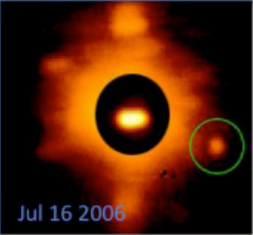
624 Hektor is the largest Jupiter trojan and the namesake of the Hektor family, with a highly elongated shape equivalent in volume to a sphere of approximately 225 to 250 kilometers diameter. It was discovered on 10 February 1907, by astronomer August Kopff at Heidelberg Observatory in southwest Germany, and named after the Trojan prince Hector, from Greek mythology. It has one small 12-kilometer sized satellite, Skamandrios, discovered in 2006.

1620 Geographos, provisional designation 1951 RA, is a highly elongated, stony asteroid, near-Earth object and potentially hazardous asteroid of the Apollo group, with a mean-diameter of approximately 2.5 km (1.6 mi). It was discovered on 14 September 1951, by astronomers Albert George Wilson and Rudolph Minkowski at the Palomar Observatory in California, United States. The asteroid was named in honor of the National Geographic Society.
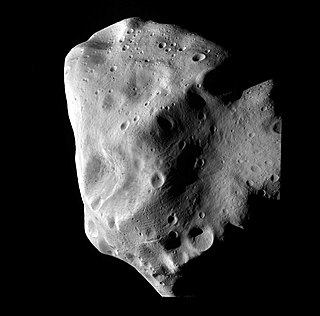
M-type asteroids are a spectral class of asteroids which appear to contain higher concentrations of metal phases than other asteroid classes, and are widely thought to be the source of iron meteorites.
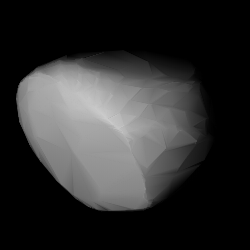
1036 Ganymed, provisional designation 1924 TD, is a stony asteroid on a highly eccentric orbit, classified as a near-Earth object of the Amor group. It was discovered by German astronomer Walter Baade at the Bergedorf Observatory in Hamburg on 23 October 1924, and named after Ganymede from Greek mythology. With a diameter of approximately 35 kilometers, Ganymed is the largest of all near-Earth objects but does not cross Earth's orbit. The S-type asteroid has a rotation period of 10.3 hours. In October 2024, it is predicted to approach Earth at a distance of 56,000,000 km; 35,000,000 mi (0.374097 AU).
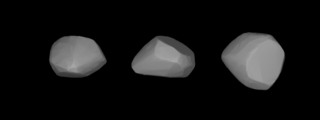
Niobe is a stony Gallia asteroid and relatively slow rotator from the central regions of the asteroid belt, approximately 90 kilometers in diameter. It was discovered by the German astronomer Robert Luther on 13 August 1861, and named after Niobe, a character in Greek mythology. In 1861, the brightness of this asteroid was shown to vary by astronomer Friedrich Tietjen.

Camilla is one of the largest asteroids from the outermost edge of the asteroid belt, approximately 250 kilometers in diameter. It is a member of the Sylvia family and located within the Cybele group. It was discovered on 17 November 1868, by English astronomer Norman Pogson at Madras Observatory, India, and named after Camilla, Queen of the Volsci in Roman mythology. The X-type asteroid is a rare trinary asteroid with two minor-planet moons discovered in 2001 and 2016, respectively. It is elongated in shape and has a short rotation period of 4.8 hours.
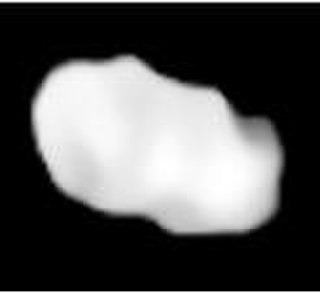
Elektra is a large outer main-belt asteroid and quadruple system with three minor-planet moons. It was discovered on 17 February 1873, by astronomer Christian Peters at Litchfield Observatory, New York, and named after Electra, an avenger in Greek mythology.

Hertha is an asteroid from the inner region of the asteroid belt, approximately 77 kilometers in diameter. Discovered on 18 February 1874 by German–American astronomer Christian Peters at the Litchfield Observatory near Clinton, New York, it was named after the Teutonic and Scandinavian goddess of fertility, Hertha, also known as Nerthus. It orbits among the Nysa asteroid family, but its classification as a metallic M-type asteroid does not match the more common F-type asteroid for this family, suggesting that it may be an interloper. Spectroscopic analysis indicates the possible presence of hydrated silicates indicating that Hertha should possibly be reclassified from its present M-type to the proposed W-type.
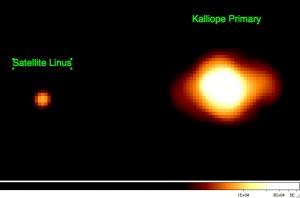
Kalliope is a large M-type asteroid from the asteroid belt discovered by J. R. Hind on 16 November 1852. It is named after Calliope, the Greek Muse of epic poetry. It is orbited by a small moon named Linus.

Elsa is a Massalia or background asteroid from the inner regions of the asteroid belt, approximately 44 kilometers in diameter. It was discovered on 7 February 1878, by Austrian astronomer Johann Palisa at the Austrian Naval Observatory in today's Croatia. The S-type asteroid has a very long rotation period of 80 hours and likely an elongated shape. The origin of its name is uncertain.

Adelheid is a dark Alauda asteroid from the outer region of the asteroid belt, approximately 121 kilometers in diameter. It was discovered by Austrian astronomer Johann Palisa at Vienna Observatory on 17 April 1888. The meaning of the asteroids's name is unknown.

849 Ara is a large, metallic background asteroid, approximately 80 kilometers in diameter, that is located in the outer region of the asteroid belt. It was discovered on 9 February 1912, by Russian astronomer Sergey Belyavsky at the Simeiz Observatory on the Crimean peninsula. The M-type asteroid has a short rotation period of 4.1 hours and is likely elongated in shape. It was named after the American Relief Administration (ARA) for the help given during the Russian famine of 1921–22.

1089 Tama, provisional designation 1927 WB, is an elongated Florian asteroid and synchronous binary system from the inner regions of the asteroid belt, approximately 12 kilometers in diameter.
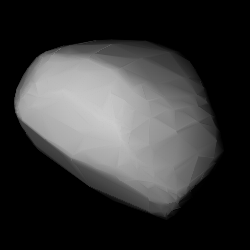
3749 Balam is a stony Flora asteroid and rare trinary system orbiting in the inner regions of asteroid belt. It also forms a secured asteroid pair with sub-kilometer sized asteroid (312497) 2009 BR60. Balam was discovered on 24 January 1982, by American astronomer Edward Bowell at Lowell's Anderson Mesa Station near Flagstaff, Arizona, and received the prov. designation 1982 BG1. It was named after Canadian astronomer David Balam. Balam measures approximately 4.1 kilometers (2.5 miles) in diameter. Its two minor-planet moons have an estimated diameter of 1.66 and 1.84 kilometers, respectively.

1627 Ivar, provisional designation 1929 SH, is an elongated stony asteroid and near-Earth object of the Amor group, approximately 15×6×6 km. It was discovered on 25 September 1929, by Danish astronomer Ejnar Hertzsprung at Leiden Southern Station, annex to the Johannesburg Observatory in South Africa. It was named after Ivar Hertzsprung, brother of the discoverer. 1627 Ivar was the first asteroid to be imaged by radar, in July 1985 by the Arecibo Observatory.

A contact binary is a small Solar System body, such as a minor planet or comet, that is composed of two bodies that have gravitated toward each other until they touch, resulting in a bilobated, peanut-like overall shape. Contact binaries are distinct from true binary systems such as binary asteroids where both components are separated. The term is also used for stellar contact binaries.

1459 Magnya, provisional designation 1937 VA, is a basaltic, slightly elongated asteroid from the outer regions of the asteroid belt, approximately 20 kilometers in diameter. Discovered by Grigory Neujmin at the Simeiz Observatory in 1937, this background asteroid was later named from the Latin word "Magnya", which means "clear, bright, wonderful" when literally translated into Russian. It is the only known basalt asteroid orbiting beyond 4 Vesta.
